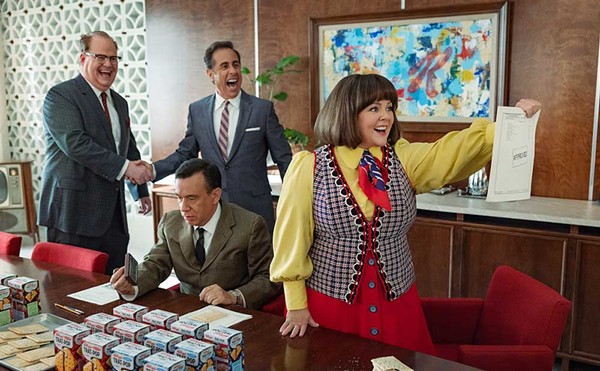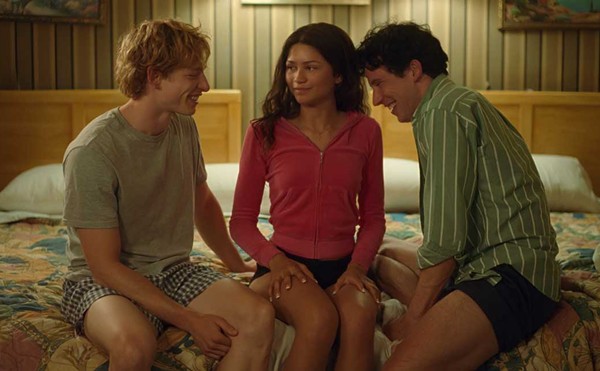If aliens were to arrive on Earth tomorrow, no doubt in short time they'd make their way to a shopping mall. And what would they learn there? Lesson No. 1: Americans love to eat. And as we are fast approaching the Season of the Binge, soon you'll find millions of people waddling a swath through the food court before heading home for leftover turkey.
There are many things that are good to eat. If we are to believe the cinema, one of them is human beings. Who can forget the scene in Texas Chainsaw Massacre, Part 2 (1986) in which the cackling patriarch of a clan of cannibals accepts the trophy for yet another chili contest. "The secret's in the meat," he boasts as the chili brimming in the prize cup slops onto his lurid, sky-blue chemise. Later on, one of his dim-witted sons gets a jolt of electricity to the metal plate in his head. Immediately he picks away at the wound and comes up with a delicious morsel of barbecued flesh. Now that's home cooking.
Even more light-hearted fare can be found in Cannibal! The Musical! (1996) When you put singing and flesh eating together, how can you go wrong, even if the production comes from "South Park" doofuses Stone and Parker? Based upon the real life of 19th century cannibal Alfred Packer, this tale involves a doomed mining expedition that fails to produce much gold on its journey, but does give us a very weird hybrid of Oklahoma! (1955) and El Topo (1971), with a good bit of Alive (1993). Here's a film unafraid to break off a leg and break out in song.
More often than not, however, cannibalism is given the straight taboo treatment. The sinister Hannibal Lector in The Silence of the Lambs (1991) seems more sinister still after he rhapsodizes about a midnight snack involving the liver of a dead man, accompanied by "fava beans and a nice Chianti." No slouch himself in the evil department, the film's squirrelly Buffalo Bill slaves away in his atelier on a flesh dress.
The original Night of the Living Dead (1968), dark and brooding, featured flesh-eating zombies created by radiation from outer space. Interestingly enough, by the time the second installment appeared 10 years later, the zombies hit the shopping mall, a place where the pickings are never slim.
No more opulent scene of cannibalism can be found than in The Cook, the Thief, His Wife & Her Lover (1990), in which Peter Greenaway has at the smug excesses of Thatcherism. A terminal lout terrorizes a posh restaurant, shitting on staff and friends alike. Meanwhile, his long-suffering wife conducts an affair in the kitchen. Eventually, the lovers are found out and the boorish anti-hero eliminates his rival. But the wife gets her revenge. In the climactic final scene, she serves her dead lover on a platter at a banquet. "Try the cock," she hisses with icy sarcasm. "It's delicious." Martin Scorsese wisely contracted Greenaway's cinematographer, Sasha Vierney, for his own The Age of Innocence (1993), which featured the opulent 17-course meals of Edith Wharton's slaves of New York.
Many cultures in the world have historically capitalized on a symbolic connection between food and sex. Catholic agrarian societies display an amazing creativity, in no small part because of the discrepancy between church teachings and the sensuous character of nature. Spanish director Bigas Luna offers a bracing critique of macho carnality vis-à-vis country vittles in the lusty Jamón Jamón (1993). The film showcases the hypocrisy of men treating women like food, but the woman is the one doing all the cooking.
A far less compelling "feminist" take on this phenomenon can be found in Like Water for Chocolate (1993). A tedious stinker from start to finish, the film tries to point out how one young woman, duty-bound to her mother but in love with a dashing young buck, turns the kitchen into a boudoir, complete with all kinds of magic-realism nonsense one expects from Latin American cinema geared toward readers of the New Yorker starved for exotica.
For politics and sensuality in the palate, look no further than Tampopo (1986) by Juzo Itami. While the hapless owner of a noodle shop tries to make the perfect bowl of noodles under the tutelage of a gourmand truck driver, a free-thinking yakuza and his randy moll indulge themselves in various excesses, including a room service orgy. Despite the beguiling, playful surface of the film, Itami's intent is to unmask and satirize the conservative conventions of food preparation, service and dining that help to structure social relations in Japanese society.
At one point, the yakuza meets his demise and, as he lies dying, he comments with dreamy relish, "Ah, now my movie is beginning." Your scribe can just imagine what his own film would be if he were condemned to hell: the title sequence from Mr. Saturday Night (1992). To this day, I devise all kinds of ruses to escape the opening three minutes, in which a cavalcade of ruthlessly awful-looking delicacies are visited by an unlucky camera. In George Orwell's 1984, Winston Smith's torment involves rats eating his face; mine is being force-fed kishka. Sometimes, the best appetite is no appetite.





